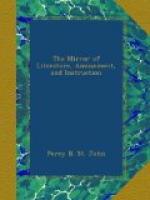I know nothing better to conclude with than a good old Christmas carol from Poor Robin’s Almanack for 1695, preserved in Brand’s Popular Antiquities, to which work I refer those of my readers who may require further information on the subject of Christmas customs and festivities:—
Now, thrice welcome, Christmas!
Which brings us good cheer;
Mince-pies and plum-pudding—
Strong ale and strong beer;
With pig, goose, and capon,
The best that may be:
So well doth the weather
And our stomachs agree.
Observe how the chimneys
Do smoke all about;
The cooks are providing
For dinner no doubt.
But those on whose tables
No victuals appear,
O may they keep Lent
All the rest of the year!
With holly and ivy,
So green and so gay,
We deck up our houses
As fresh as the day;
With bays and rosemary,
And laurel complete,—
And every one now
Is a king in conceit,
But as for curmudgeons
Who will not be free,
I wish they may die
On a two-legged tree!
WILLIAM PALIN.
* * * * *
To the proof that we are not unseasonable, here are in this sheet—Merry Christmas! the Turks_, (of a darker hue;) Exhibitions; a Consolatory “Population” Scrap; Hints for Singing after a good master; a Bunch of Facts on Turnips; a column on Liston—that living limner of laughter; and other seasonables.
* * * * *
MANNERS & CUSTOMS OF ALL NATIONS.
No. XVII.
* * * * *
THE TURKS.
(For the Mirror.)
The Turks have a manly and prepossessing demeanour; being generally of a good stature, and remarkably well formed in their limbs. The men shave their heads, but wear long beards, and are extremely proud of their mustaches, which are usually turned downwards, and which give the other features of the face a cast of peculiar pensiveness. They wear turbans, sometimes white, of an enormous size on their heads, and never remove them but when they go to repose. Their breeches, or drawers, are united with their stockings, and they have slippers, which they never put off but when they enter a mosque, or the house of a great man. Large shirts are worn, and over them is a vest tied with a sash; the outer garment being a sort of loose gown. Every man, in whatever station he is, carries a dagger in his sash. The women’s attire much resembles that of the other sex, only they have a cap on their heads, something like a bishop’s mitre, instead of a turban. Their hair is beautiful and long, mostly black, but their faces, which are remarkably handsome, are so covered when they walk out, that nothing is to be seen but their eyes. The ladies of the sultan’s haram are lovely




